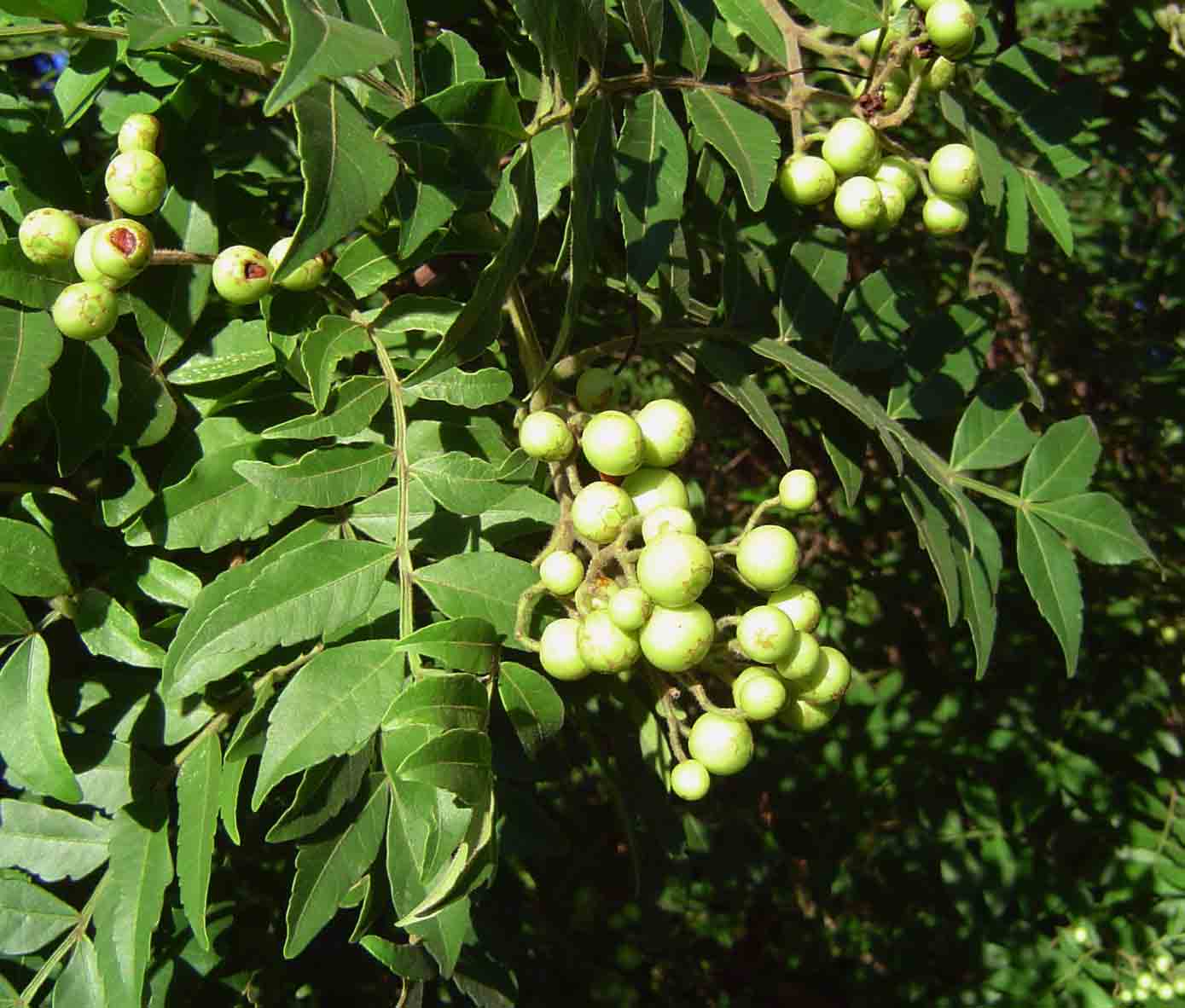Harrisonia abyssinica Oliv.
| Botanical Name | Harrisonia abyssinica Oliv. |
| Order: | Sapindales |
| Family: | Rutaceae |
| Genus: | Harrisonia |
| Species: | H. abyssinica |
| Common Names: | Baingou (French) |
Plant Synonyms
Harrisonia occidentalis Engl.,
Zanthoxylum guineense Stapf.
Plant Local Names
Ghana: Asante - Fintinko,
Guinea Conakry: Kpele - Zhinwuon nyegolo
Cote d'lvoire: Anyi - Baingu
Nigeria: Hausa - Arujere
Sierra Leone: Kissi - Mama kundu
Togo: Ewe - Xedja, Mina - Hedjan, Adja -Xedjatsi
Plant Habitat
Dry evergreen forest patches or xerophytic (in Savannah). It is often found in coastal regions.
Plant Material of Interest
Leaf or stem bark, Root bark
Plant Description
Highly branched shrub, sometimes climbing, reaching 8 m high; bark light brown or grey with long, flexible branches; leaves alternate, odd- pinnate compound, comprise of 2 to 7 pairs of leaflets up to 25 cm long; inflorescences axillary or terminal panicle, erect, glabrous or hairy, 2 to 14 cm long; flowers bisexual, regular, 4 to 6 lobes, glabrous; fruit depressed, globose, berry red or black at maturity with 4-8 lobes.
Plant Used Parts
Plant Uses
The powdered root bark and root decoction or infusion is used against venereal diseases, fever, malaria, diarrhoea, intestinal worms, urinary diseases, gonorrhea, stomach and tooth ache. Leaves with seeds of Aframomum melegueta kaolin and salt is effective against vaginal
discharge. The roots are chewed with palm kernel as an aphrodisiac (Balde, 1990), while the root decoction is used against malaria, gonorrhoea, tuberculosis and schistosomiasis. The decoction of young roots is effective against dizziness, insomnia, nausea'1 vomiting, orchitis and tuberculosis. The decoction can also cause abortion (Kirira et al., 2006; Hassanali et al., 1987).
Plant Therapeutic Action
Antimalarial, antibacterial, antifungal, antiviral (Anani et al.. 2002; Hudson et al., 2000; Fabry et al., 1998; Balde et al., 1995; Balde et al., 1990; Sawhney et al., 1978).
Plant Precaution for Use
Do not exceed the stated doses
Plant Adverse Effect
May cause headache and dizziness
Plant Contraindication
Pregnancy and lactation
Plant Dosage Forms
Decoction: 30 g of dried plant material in 900 ml water; boil until reduced to 600 ml; two tablespoonfuls three times daily.
Plant Dosage
Decoction, infusion
Plant Storage
Store in a cool dry place away from light
Plant Chromatographic Fingerprint
Analytical TLC on silica gel G60 F254, 0.25 mm layer in petroleum ether (40 60 °C)/chloroform [2:8], detection in daylight, after spraying with anisaldehyde (05 ml) mixed with 10 ml glacial acetic acid, 85 ml methanol and 5 ml concentrated sulphuric acid and heated to 100-110°C for 5-10 min. Presence of four characteristic spots with Rf sof 092 (pink), 0.69 (purple), 0.47 (purple) and 0.34 (purple).
Plant Constituents
Steroids/triterpenes: sitosterol, stigmasterol, campesterol, poriferasteroi; stigmastenone, stigmastatrienone, sitostenone. friedelanone; methylcholestenone; cycioabyssinone (Balde et al., 2000); limonoids: obacunone; harrisonine; acetoxyharrisonine; diacetoxyharrisonine; pedonine; atalantolide; adehydroriciopsine (Okorie, 1982, Liu et al., 1982; Rajah et al., 1997, 1999; Chabbra et at, 1984, Nakanishl, 1982, Hassanali. 1987 ; Raiab et al., 1999; Rugutt et al., 2001; Balde et al., 1987, 1988) ; quassinoide: perioraquasslne A (Rajah et al., 1999); chromones: alloptaeroxylline; hydroxymethyl alloptaeroxylline; peucenine (Okorie, 1982; Balde et al., 1987); terpenoid (prenylated polyketides): oumarone, bissaone, aissatone, daiandaone (Balde et al., 2001); fatty acids; anthocanidines, polysaccharides, polyuronides (Balde, 1990); anthocyanidins, saponins, essential oils (Chhabra et al,1984)
Plant References
Ananl, K., Hudson. J.B., Desouza, C., Akpagana, K., Tower, G.H.N. et al. (2002). investigation of medicinal plants of Togo for antiviral and antimicrobial activities. Pharmaceutical Biology 38:40-45.
Balde, A.M., Vanhaelen, M, Ottinge, Ft. (1987). A chromone from the root-bark of Harrisonia abyssinica Phytochemistry 26(8):2415-2416.
Balde, A.M., Vanhaelen, M, Daloze, D. (1988). 5-Dehydrooriciopsin, A Ring-D cleaved tetranortriterpenoid from Harrisonia abyssinica Phytochemistry 27(3):942-943.
Balde, A.M., Van Marck, E_A., Kestens, L., Gigase, P.L., Vlietinck, Ad. (1989).
Schistosomlcidal Effect of Pavetta owariensis and Harrisonia abyssinican Mice Infected With Schistosoma mansoniPlanta Medlca 55(1):41-43.
Balde, MA. (1990). in Biological and Phytochemical Investigations on three plants widely used in Guinean traditional medicine. Doctoral Thesis Pharmaceutical Sciences. University of Antwerp, Belgium.
Balde, A.M., Pieters, L., De Bruyne, T., Geerts, S. et al. (1995). Biological investigations on
Harrisonia abyssinicé’hytomedicine 4:299-302
Balde, A.M., Apers, 8., De Bruyne, T., Van Den Heuvel, H. et at. (2000). Steroids from Harrisoniam abyssinica Planta Medica 68:67-69.
Balde. A.M., Apers, 8., Claeys, M, Pieters, L., Vlietinck, Ad. (2001). Cycloabyssinone, a new cycloterpene from Harrisonia Fitoterapia 72:438—440.

